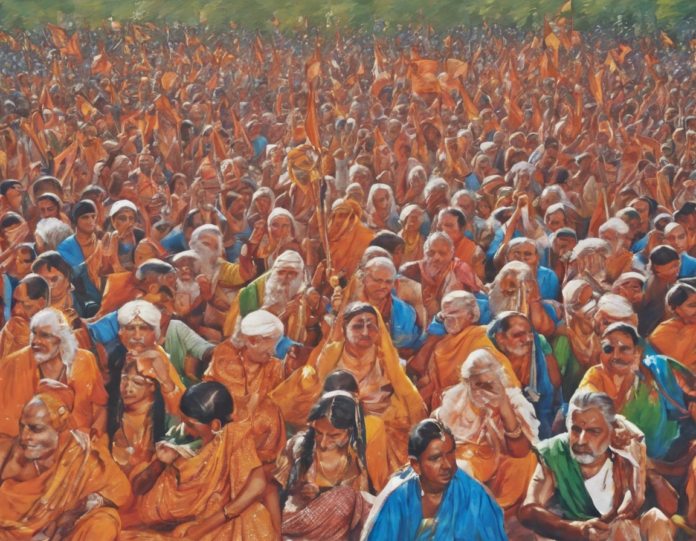Introduction
Gantantra Diwas, also known as Republic Day, is celebrated in India on the 26th of January every year to commemorate the day when the Constitution of India came into effect in 1950. This day holds great significance for the country as it reaffirms the principles of justice, liberty, equality, and fraternity as enshrined in the Indian Constitution. The Constitution of India is not just a legal document; it is a social contract that governs the rights and duties of citizens, the powers of the government, and the functioning of the institutions. In this blog post, we will delve deeper into the samvidhanik mahatva (constitutional significance) of Gantantra Diwas and explore why the Constitution plays a pivotal role in the making of modern India.
The Preamble: The Soul of the Constitution
The Preamble to the Indian Constitution is like a guiding light that illuminates the path of samvidhanik nirmaan (constitutional creation). It declares India to be a sovereign, socialist, secular, and democratic republic and promises justice, liberty, equality, and fraternity to all its citizens. The words of the Preamble encapsulate the aspirations and values of the Indian polity and serve as a mooladhar (foundation) for the entire constitutional edifice.
Fundamental Rights: Safeguarding Liberties
The Constitution of India guarantees fundamental rights to its citizens, which include the right to equality, freedom of speech and expression, right to privacy, right against exploitation, and right to constitutional remedies. These rights act as raksha kavach (shield) against arbitrary state action and ensure that every individual is treated with dignity and respect. Gantantra Diwas is a reminder of the importance of upholding these rights and freedoms to nurture a culture of democracy and pluralism in the country.
Directive Principles of State Policy: Shaping Social Justice
In addition to fundamental rights, the Indian Constitution also contains Directive Principles of State Policy, which guide the government in creating a just and equitable society. These principles enjoin the state to work towards securing samajik nyay (social justice), lok kalyan (public welfare), and samriddhi (prosperity) for all its citizens. Gantantra Diwas serves as a moment to reflect on the progress made in realizing these directive principles and to recommit to the idea of an inclusive and egalitarian society.
Separation of Powers: Ensuring Checks and Balances
The Indian Constitution delineates the powers of the legislature, executive, and judiciary to prevent any one organ of the state from becoming too powerful. This system of shakti viyog (separation of powers) ensures checks and balances and fosters accountability in governance. Gantantra Diwas underscores the importance of upholding the independence of the judiciary and the autonomy of other constitutional bodies to safeguard the democratic fabric of the nation.
Federal Structure: Balancing Centre-State Relations
India follows a federal system of governance where powers are divided between the central government and the state governments. The Constitution demarcates the kendra (centre) and rajya (state) lists to avoid any encroachment on each other’s domain. Gantantra Diwas is a celebration of this cooperative federalism that provides for samvad (dialogue) and samriddhi (prosperity) at all levels of governance.
Conclusion
In conclusion, Gantantra Diwas is not just a day of pomp and pageantry; it is a mahotsav (festival) of democracy that reaffirms the faith in the ideals and values enshrined in the Indian Constitution. On this day, Indians across the country come together to celebrate the samvidhanik saahas (constitutional courage) that has guided the nation through its journey of nation-building. As we mark another Republic Day, let us recommit ourselves to the principles of justice, liberty, equality, and fraternity and strive to build a more inclusive and harmonious society.
FAQs
1. What is the significance of Gantantra Diwas in Indian history?
Gantantra Diwas marks the day when the Constitution of India came into effect in 1950, replacing the Government of India Act (1935) as the governing document of the country. It symbolizes the transition of India from a British dominion to a sovereign republic.
2. How is Gantantra Diwas celebrated in India?
Gantantra Diwas is celebrated with great enthusiasm across the country. The main event takes place in New Delhi, where the President of India hoists the national flag and a grand parade showcases the country’s cultural diversity and military prowess.
3. Why is the Indian Constitution called a living document?
The Indian Constitution is called a living document because it is adaptable and has stood the test of time by accommodating various amendments to address the emerging needs of the nation. Its provisions continue to shape the socio-political landscape of India.
4. What is the role of the President of India on Gantantra Diwas?
The President of India plays a key role on Gantantra Diwas by hoisting the national flag at the Rajpath in New Delhi, followed by the rendition of the national anthem and a 21-gun salute. The President also addresses the nation on this occasion.
5. How does Gantantra Diwas promote national unity and patriotism?
Gantantra Diwas serves as a unifying force that brings together people from diverse cultures, languages, and regions to celebrate the democratic ethos of the country. It instills a sense of pride in the Indian Constitution and fosters patriotism among citizens.

